AI Chatbot: Development Procedure, AI/ML Usage, Code Examples, Aspects
VerifiedAdded on 2022/10/19
|20
|3774
|15
Project
AI Summary
This project report provides a comprehensive overview of AI-based chatbot development. It begins with an introduction to the significance of AI in modern business systems, emphasizing the role of intelligent chatbots in enhancing business interactions and personalizing user experiences. The report details the development procedure of a chatbot, explaining the core components and their functionalities, including the front-end, middleware, static content system, NLP adapter unit, core processing module, and cognitive memories. It explores the usage of AI and machine learning, covering techniques like pattern matching, natural language understanding (NLU), and natural language processing (NLP), including the application of LSTM, spaCy, and Tf-idf. Furthermore, the report provides example code for chatbot development in Python, illustrating the practical implementation of the discussed concepts. The document also highlights different aspects of chatbot design and concludes with a summary of the key takeaways. The report is a valuable resource for understanding the architecture, development, and application of AI-based chatbots.
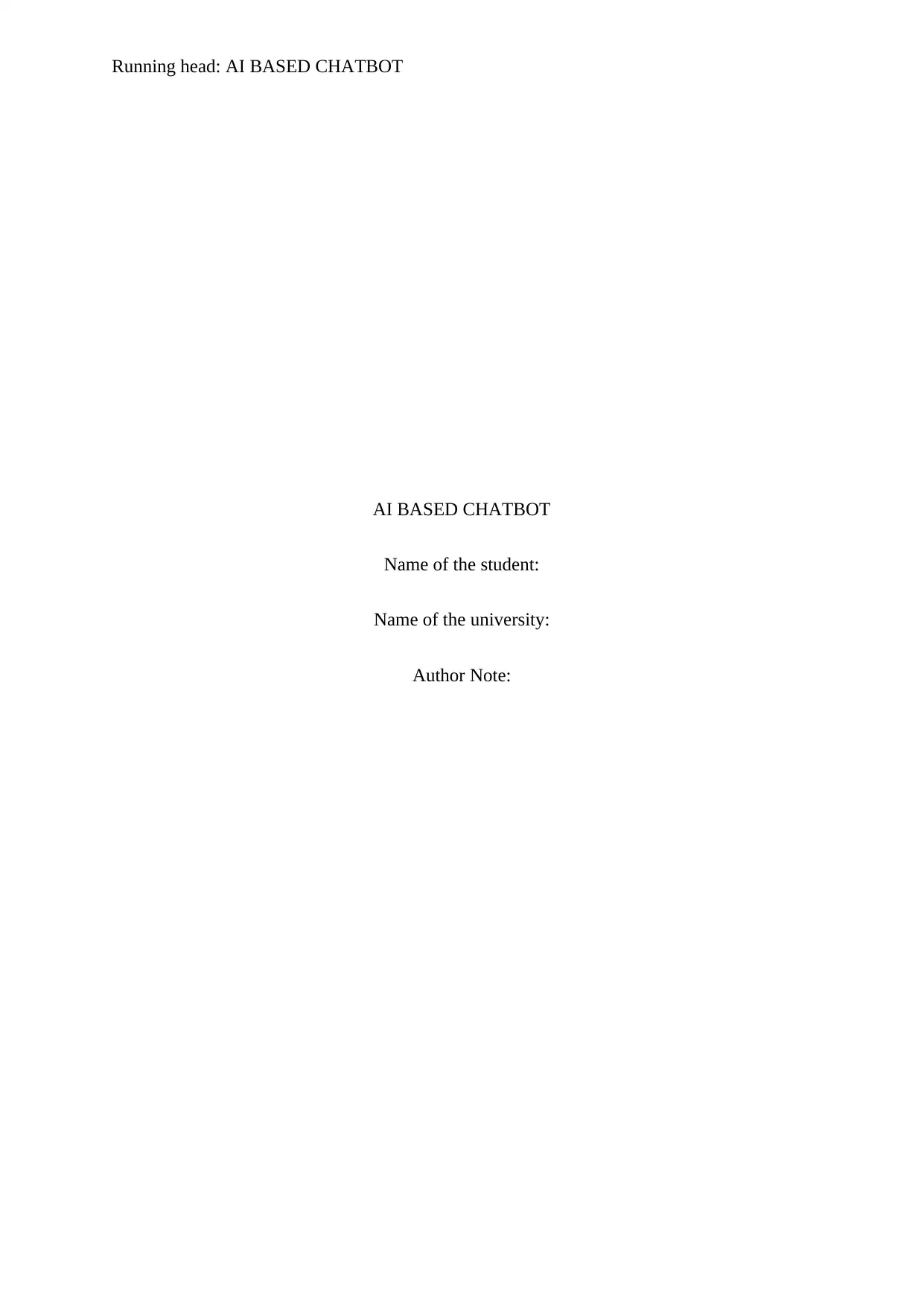
Running head: AI BASED CHATBOT
AI BASED CHATBOT
Name of the student:
Name of the university:
Author Note:
AI BASED CHATBOT
Name of the student:
Name of the university:
Author Note:
Paraphrase This Document
Need a fresh take? Get an instant paraphrase of this document with our AI Paraphraser
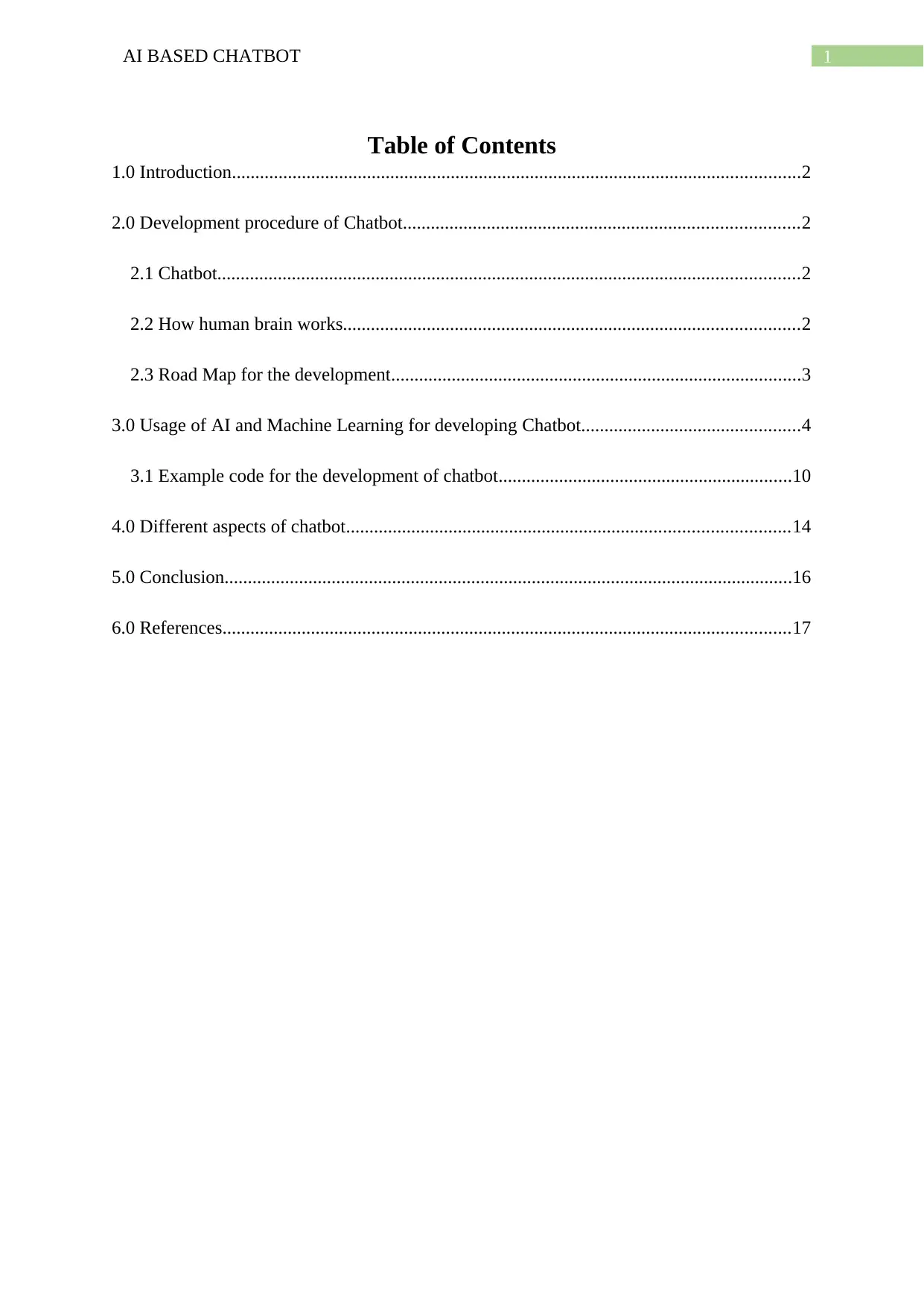
1AI BASED CHATBOT
Table of Contents
1.0 Introduction..........................................................................................................................2
2.0 Development procedure of Chatbot.....................................................................................2
2.1 Chatbot.............................................................................................................................2
2.2 How human brain works..................................................................................................2
2.3 Road Map for the development........................................................................................3
3.0 Usage of AI and Machine Learning for developing Chatbot...............................................4
3.1 Example code for the development of chatbot...............................................................10
4.0 Different aspects of chatbot...............................................................................................14
5.0 Conclusion..........................................................................................................................16
6.0 References..........................................................................................................................17
Table of Contents
1.0 Introduction..........................................................................................................................2
2.0 Development procedure of Chatbot.....................................................................................2
2.1 Chatbot.............................................................................................................................2
2.2 How human brain works..................................................................................................2
2.3 Road Map for the development........................................................................................3
3.0 Usage of AI and Machine Learning for developing Chatbot...............................................4
3.1 Example code for the development of chatbot...............................................................10
4.0 Different aspects of chatbot...............................................................................................14
5.0 Conclusion..........................................................................................................................16
6.0 References..........................................................................................................................17
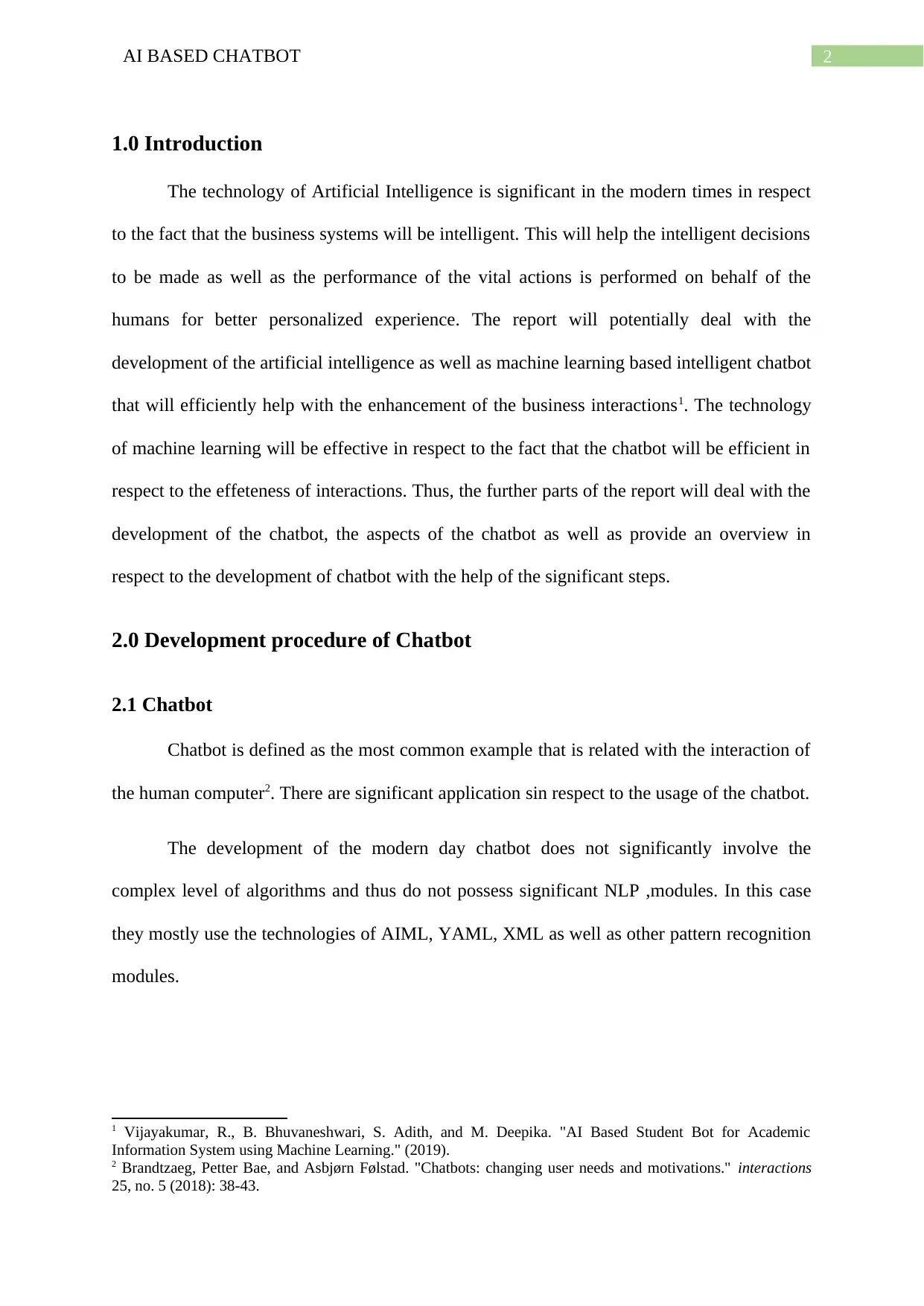
2AI BASED CHATBOT
1.0 Introduction
The technology of Artificial Intelligence is significant in the modern times in respect
to the fact that the business systems will be intelligent. This will help the intelligent decisions
to be made as well as the performance of the vital actions is performed on behalf of the
humans for better personalized experience. The report will potentially deal with the
development of the artificial intelligence as well as machine learning based intelligent chatbot
that will efficiently help with the enhancement of the business interactions1. The technology
of machine learning will be effective in respect to the fact that the chatbot will be efficient in
respect to the effeteness of interactions. Thus, the further parts of the report will deal with the
development of the chatbot, the aspects of the chatbot as well as provide an overview in
respect to the development of chatbot with the help of the significant steps.
2.0 Development procedure of Chatbot
2.1 Chatbot
Chatbot is defined as the most common example that is related with the interaction of
the human computer2. There are significant application sin respect to the usage of the chatbot.
The development of the modern day chatbot does not significantly involve the
complex level of algorithms and thus do not possess significant NLP ,modules. In this case
they mostly use the technologies of AIML, YAML, XML as well as other pattern recognition
modules.
1 Vijayakumar, R., B. Bhuvaneshwari, S. Adith, and M. Deepika. "AI Based Student Bot for Academic
Information System using Machine Learning." (2019).
2 Brandtzaeg, Petter Bae, and Asbjørn Følstad. "Chatbots: changing user needs and motivations." interactions
25, no. 5 (2018): 38-43.
1.0 Introduction
The technology of Artificial Intelligence is significant in the modern times in respect
to the fact that the business systems will be intelligent. This will help the intelligent decisions
to be made as well as the performance of the vital actions is performed on behalf of the
humans for better personalized experience. The report will potentially deal with the
development of the artificial intelligence as well as machine learning based intelligent chatbot
that will efficiently help with the enhancement of the business interactions1. The technology
of machine learning will be effective in respect to the fact that the chatbot will be efficient in
respect to the effeteness of interactions. Thus, the further parts of the report will deal with the
development of the chatbot, the aspects of the chatbot as well as provide an overview in
respect to the development of chatbot with the help of the significant steps.
2.0 Development procedure of Chatbot
2.1 Chatbot
Chatbot is defined as the most common example that is related with the interaction of
the human computer2. There are significant application sin respect to the usage of the chatbot.
The development of the modern day chatbot does not significantly involve the
complex level of algorithms and thus do not possess significant NLP ,modules. In this case
they mostly use the technologies of AIML, YAML, XML as well as other pattern recognition
modules.
1 Vijayakumar, R., B. Bhuvaneshwari, S. Adith, and M. Deepika. "AI Based Student Bot for Academic
Information System using Machine Learning." (2019).
2 Brandtzaeg, Petter Bae, and Asbjørn Følstad. "Chatbots: changing user needs and motivations." interactions
25, no. 5 (2018): 38-43.
⊘ This is a preview!⊘
Do you want full access?
Subscribe today to unlock all pages.

Trusted by 1+ million students worldwide
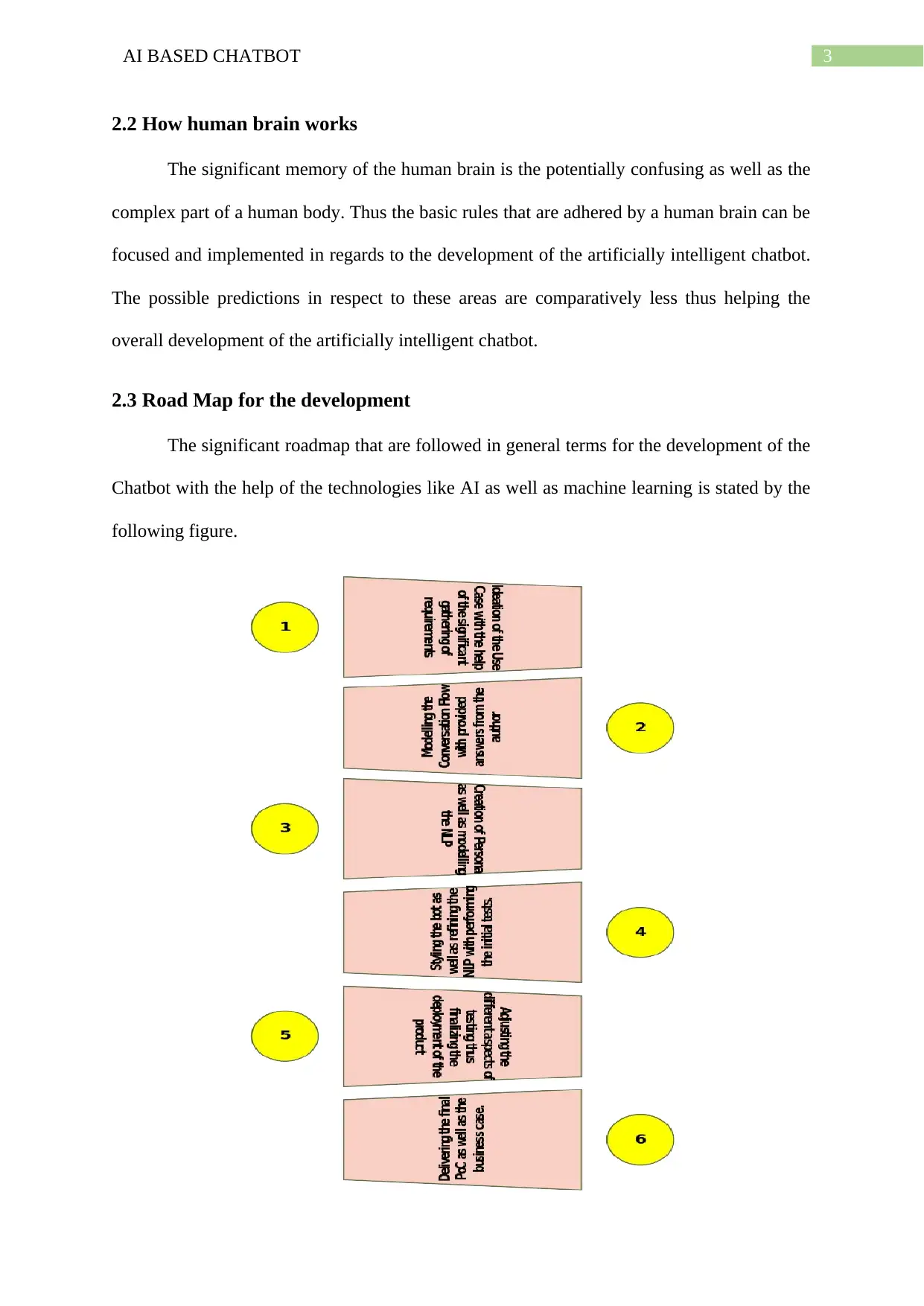
3AI BASED CHATBOT
2.2 How human brain works
The significant memory of the human brain is the potentially confusing as well as the
complex part of a human body. Thus the basic rules that are adhered by a human brain can be
focused and implemented in regards to the development of the artificially intelligent chatbot.
The possible predictions in respect to these areas are comparatively less thus helping the
overall development of the artificially intelligent chatbot.
2.3 Road Map for the development
The significant roadmap that are followed in general terms for the development of the
Chatbot with the help of the technologies like AI as well as machine learning is stated by the
following figure.
2.2 How human brain works
The significant memory of the human brain is the potentially confusing as well as the
complex part of a human body. Thus the basic rules that are adhered by a human brain can be
focused and implemented in regards to the development of the artificially intelligent chatbot.
The possible predictions in respect to these areas are comparatively less thus helping the
overall development of the artificially intelligent chatbot.
2.3 Road Map for the development
The significant roadmap that are followed in general terms for the development of the
Chatbot with the help of the technologies like AI as well as machine learning is stated by the
following figure.
Paraphrase This Document
Need a fresh take? Get an instant paraphrase of this document with our AI Paraphraser
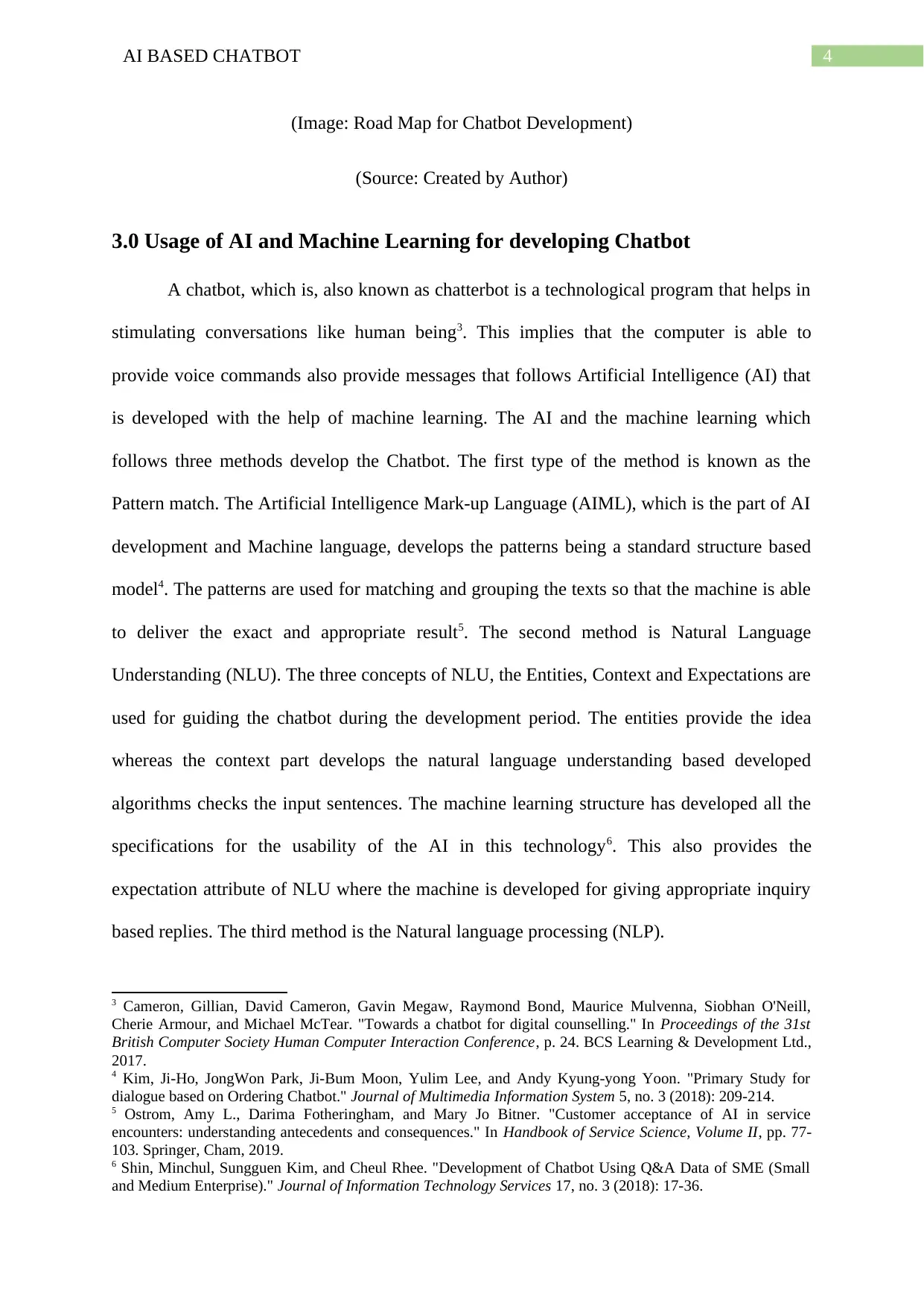
4AI BASED CHATBOT
(Image: Road Map for Chatbot Development)
(Source: Created by Author)
3.0 Usage of AI and Machine Learning for developing Chatbot
A chatbot, which is, also known as chatterbot is a technological program that helps in
stimulating conversations like human being3. This implies that the computer is able to
provide voice commands also provide messages that follows Artificial Intelligence (AI) that
is developed with the help of machine learning. The AI and the machine learning which
follows three methods develop the Chatbot. The first type of the method is known as the
Pattern match. The Artificial Intelligence Mark-up Language (AIML), which is the part of AI
development and Machine language, develops the patterns being a standard structure based
model4. The patterns are used for matching and grouping the texts so that the machine is able
to deliver the exact and appropriate result5. The second method is Natural Language
Understanding (NLU). The three concepts of NLU, the Entities, Context and Expectations are
used for guiding the chatbot during the development period. The entities provide the idea
whereas the context part develops the natural language understanding based developed
algorithms checks the input sentences. The machine learning structure has developed all the
specifications for the usability of the AI in this technology6. This also provides the
expectation attribute of NLU where the machine is developed for giving appropriate inquiry
based replies. The third method is the Natural language processing (NLP).
3 Cameron, Gillian, David Cameron, Gavin Megaw, Raymond Bond, Maurice Mulvenna, Siobhan O'Neill,
Cherie Armour, and Michael McTear. "Towards a chatbot for digital counselling." In Proceedings of the 31st
British Computer Society Human Computer Interaction Conference, p. 24. BCS Learning & Development Ltd.,
2017.
4 Kim, Ji-Ho, JongWon Park, Ji-Bum Moon, Yulim Lee, and Andy Kyung-yong Yoon. "Primary Study for
dialogue based on Ordering Chatbot." Journal of Multimedia Information System 5, no. 3 (2018): 209-214.
5 Ostrom, Amy L., Darima Fotheringham, and Mary Jo Bitner. "Customer acceptance of AI in service
encounters: understanding antecedents and consequences." In Handbook of Service Science, Volume II, pp. 77-
103. Springer, Cham, 2019.
6 Shin, Minchul, Sungguen Kim, and Cheul Rhee. "Development of Chatbot Using Q&A Data of SME (Small
and Medium Enterprise)." Journal of Information Technology Services 17, no. 3 (2018): 17-36.
(Image: Road Map for Chatbot Development)
(Source: Created by Author)
3.0 Usage of AI and Machine Learning for developing Chatbot
A chatbot, which is, also known as chatterbot is a technological program that helps in
stimulating conversations like human being3. This implies that the computer is able to
provide voice commands also provide messages that follows Artificial Intelligence (AI) that
is developed with the help of machine learning. The AI and the machine learning which
follows three methods develop the Chatbot. The first type of the method is known as the
Pattern match. The Artificial Intelligence Mark-up Language (AIML), which is the part of AI
development and Machine language, develops the patterns being a standard structure based
model4. The patterns are used for matching and grouping the texts so that the machine is able
to deliver the exact and appropriate result5. The second method is Natural Language
Understanding (NLU). The three concepts of NLU, the Entities, Context and Expectations are
used for guiding the chatbot during the development period. The entities provide the idea
whereas the context part develops the natural language understanding based developed
algorithms checks the input sentences. The machine learning structure has developed all the
specifications for the usability of the AI in this technology6. This also provides the
expectation attribute of NLU where the machine is developed for giving appropriate inquiry
based replies. The third method is the Natural language processing (NLP).
3 Cameron, Gillian, David Cameron, Gavin Megaw, Raymond Bond, Maurice Mulvenna, Siobhan O'Neill,
Cherie Armour, and Michael McTear. "Towards a chatbot for digital counselling." In Proceedings of the 31st
British Computer Society Human Computer Interaction Conference, p. 24. BCS Learning & Development Ltd.,
2017.
4 Kim, Ji-Ho, JongWon Park, Ji-Bum Moon, Yulim Lee, and Andy Kyung-yong Yoon. "Primary Study for
dialogue based on Ordering Chatbot." Journal of Multimedia Information System 5, no. 3 (2018): 209-214.
5 Ostrom, Amy L., Darima Fotheringham, and Mary Jo Bitner. "Customer acceptance of AI in service
encounters: understanding antecedents and consequences." In Handbook of Service Science, Volume II, pp. 77-
103. Springer, Cham, 2019.
6 Shin, Minchul, Sungguen Kim, and Cheul Rhee. "Development of Chatbot Using Q&A Data of SME (Small
and Medium Enterprise)." Journal of Information Technology Services 17, no. 3 (2018): 17-36.
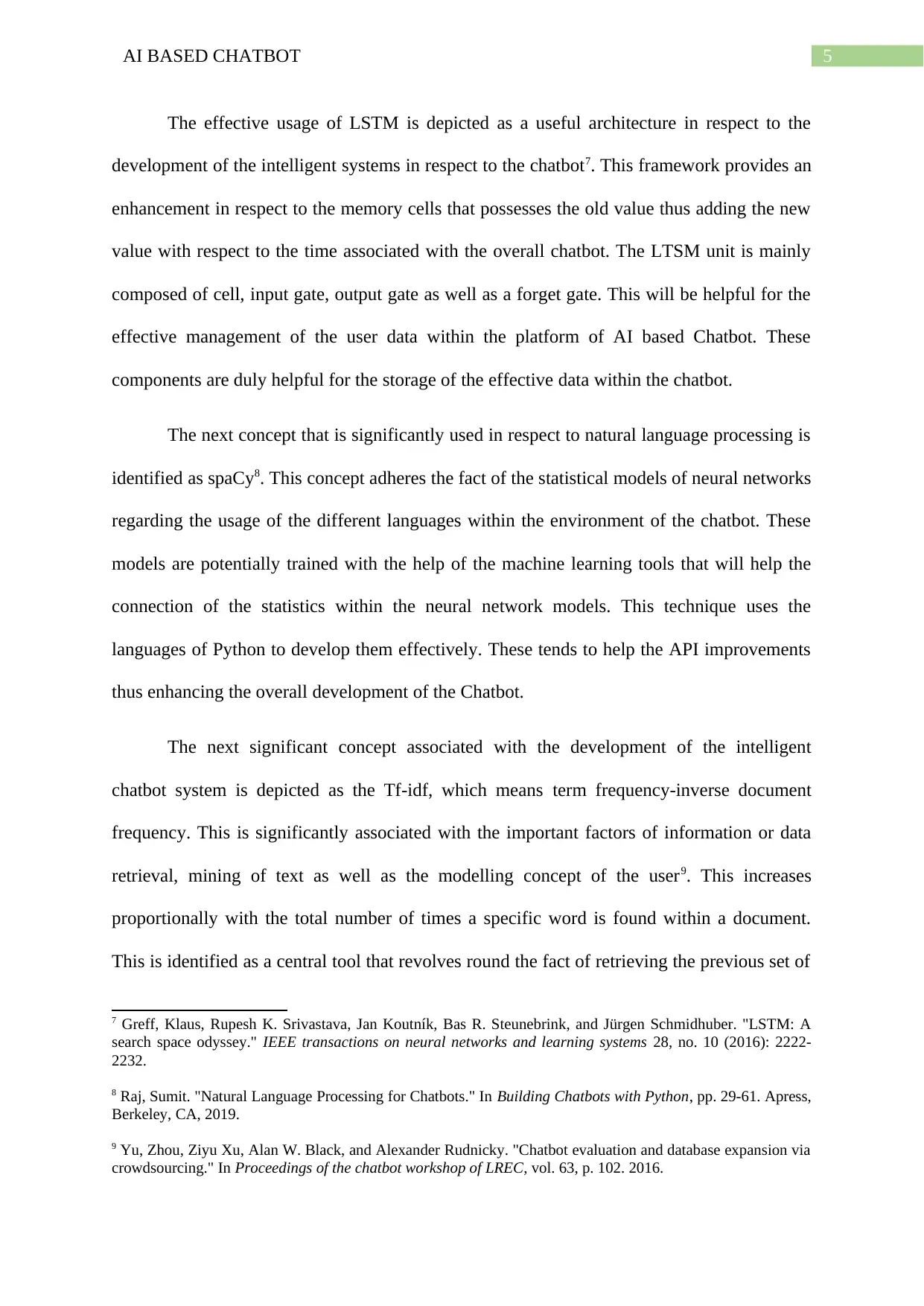
5AI BASED CHATBOT
The effective usage of LSTM is depicted as a useful architecture in respect to the
development of the intelligent systems in respect to the chatbot7. This framework provides an
enhancement in respect to the memory cells that possesses the old value thus adding the new
value with respect to the time associated with the overall chatbot. The LTSM unit is mainly
composed of cell, input gate, output gate as well as a forget gate. This will be helpful for the
effective management of the user data within the platform of AI based Chatbot. These
components are duly helpful for the storage of the effective data within the chatbot.
The next concept that is significantly used in respect to natural language processing is
identified as spaCy8. This concept adheres the fact of the statistical models of neural networks
regarding the usage of the different languages within the environment of the chatbot. These
models are potentially trained with the help of the machine learning tools that will help the
connection of the statistics within the neural network models. This technique uses the
languages of Python to develop them effectively. These tends to help the API improvements
thus enhancing the overall development of the Chatbot.
The next significant concept associated with the development of the intelligent
chatbot system is depicted as the Tf-idf, which means term frequency-inverse document
frequency. This is significantly associated with the important factors of information or data
retrieval, mining of text as well as the modelling concept of the user9. This increases
proportionally with the total number of times a specific word is found within a document.
This is identified as a central tool that revolves round the fact of retrieving the previous set of
7 Greff, Klaus, Rupesh K. Srivastava, Jan Koutník, Bas R. Steunebrink, and Jürgen Schmidhuber. "LSTM: A
search space odyssey." IEEE transactions on neural networks and learning systems 28, no. 10 (2016): 2222-
2232.
8 Raj, Sumit. "Natural Language Processing for Chatbots." In Building Chatbots with Python, pp. 29-61. Apress,
Berkeley, CA, 2019.
9 Yu, Zhou, Ziyu Xu, Alan W. Black, and Alexander Rudnicky. "Chatbot evaluation and database expansion via
crowdsourcing." In Proceedings of the chatbot workshop of LREC, vol. 63, p. 102. 2016.
The effective usage of LSTM is depicted as a useful architecture in respect to the
development of the intelligent systems in respect to the chatbot7. This framework provides an
enhancement in respect to the memory cells that possesses the old value thus adding the new
value with respect to the time associated with the overall chatbot. The LTSM unit is mainly
composed of cell, input gate, output gate as well as a forget gate. This will be helpful for the
effective management of the user data within the platform of AI based Chatbot. These
components are duly helpful for the storage of the effective data within the chatbot.
The next concept that is significantly used in respect to natural language processing is
identified as spaCy8. This concept adheres the fact of the statistical models of neural networks
regarding the usage of the different languages within the environment of the chatbot. These
models are potentially trained with the help of the machine learning tools that will help the
connection of the statistics within the neural network models. This technique uses the
languages of Python to develop them effectively. These tends to help the API improvements
thus enhancing the overall development of the Chatbot.
The next significant concept associated with the development of the intelligent
chatbot system is depicted as the Tf-idf, which means term frequency-inverse document
frequency. This is significantly associated with the important factors of information or data
retrieval, mining of text as well as the modelling concept of the user9. This increases
proportionally with the total number of times a specific word is found within a document.
This is identified as a central tool that revolves round the fact of retrieving the previous set of
7 Greff, Klaus, Rupesh K. Srivastava, Jan Koutník, Bas R. Steunebrink, and Jürgen Schmidhuber. "LSTM: A
search space odyssey." IEEE transactions on neural networks and learning systems 28, no. 10 (2016): 2222-
2232.
8 Raj, Sumit. "Natural Language Processing for Chatbots." In Building Chatbots with Python, pp. 29-61. Apress,
Berkeley, CA, 2019.
9 Yu, Zhou, Ziyu Xu, Alan W. Black, and Alexander Rudnicky. "Chatbot evaluation and database expansion via
crowdsourcing." In Proceedings of the chatbot workshop of LREC, vol. 63, p. 102. 2016.
⊘ This is a preview!⊘
Do you want full access?
Subscribe today to unlock all pages.

Trusted by 1+ million students worldwide
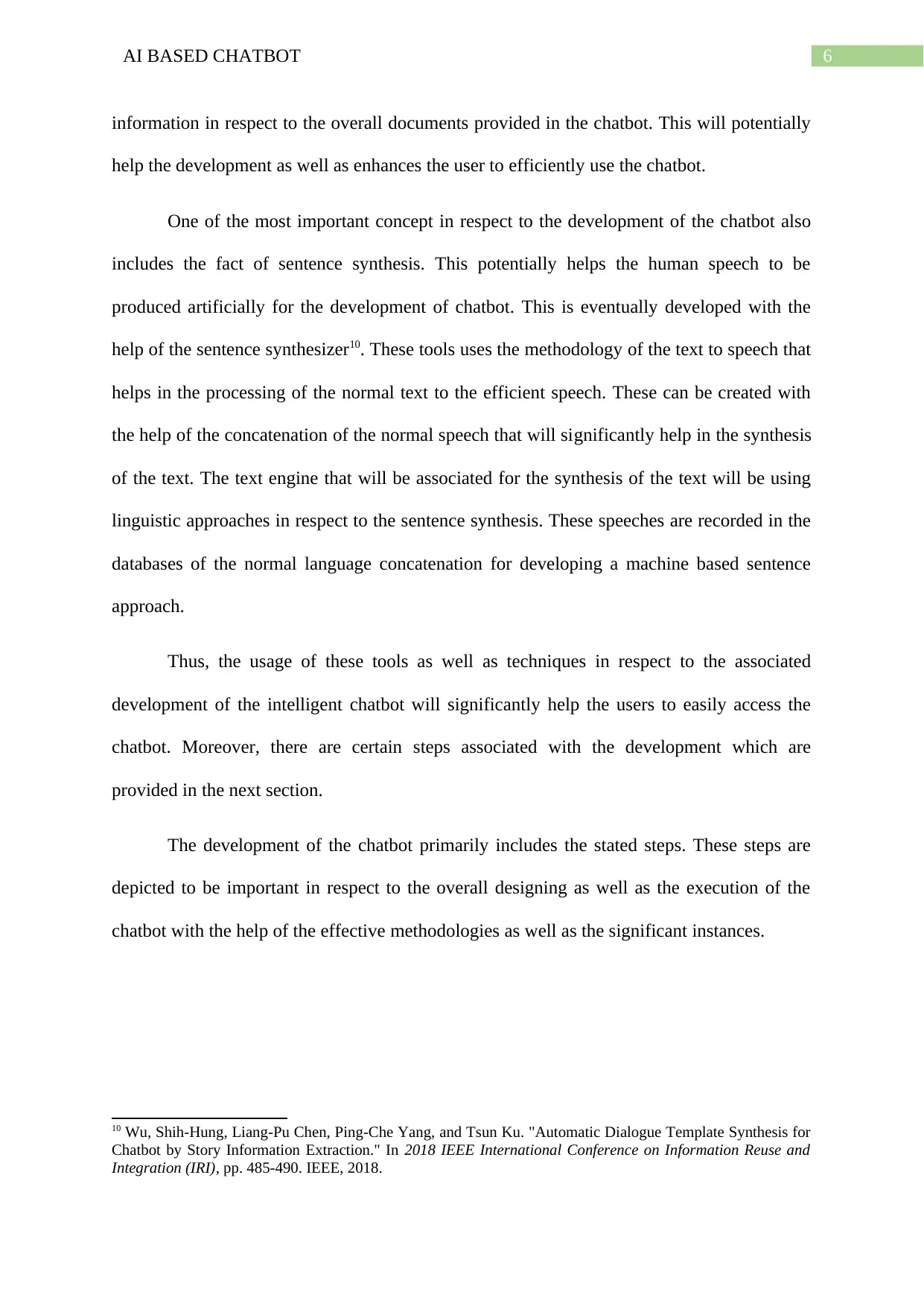
6AI BASED CHATBOT
information in respect to the overall documents provided in the chatbot. This will potentially
help the development as well as enhances the user to efficiently use the chatbot.
One of the most important concept in respect to the development of the chatbot also
includes the fact of sentence synthesis. This potentially helps the human speech to be
produced artificially for the development of chatbot. This is eventually developed with the
help of the sentence synthesizer10. These tools uses the methodology of the text to speech that
helps in the processing of the normal text to the efficient speech. These can be created with
the help of the concatenation of the normal speech that will significantly help in the synthesis
of the text. The text engine that will be associated for the synthesis of the text will be using
linguistic approaches in respect to the sentence synthesis. These speeches are recorded in the
databases of the normal language concatenation for developing a machine based sentence
approach.
Thus, the usage of these tools as well as techniques in respect to the associated
development of the intelligent chatbot will significantly help the users to easily access the
chatbot. Moreover, there are certain steps associated with the development which are
provided in the next section.
The development of the chatbot primarily includes the stated steps. These steps are
depicted to be important in respect to the overall designing as well as the execution of the
chatbot with the help of the effective methodologies as well as the significant instances.
10 Wu, Shih-Hung, Liang-Pu Chen, Ping-Che Yang, and Tsun Ku. "Automatic Dialogue Template Synthesis for
Chatbot by Story Information Extraction." In 2018 IEEE International Conference on Information Reuse and
Integration (IRI), pp. 485-490. IEEE, 2018.
information in respect to the overall documents provided in the chatbot. This will potentially
help the development as well as enhances the user to efficiently use the chatbot.
One of the most important concept in respect to the development of the chatbot also
includes the fact of sentence synthesis. This potentially helps the human speech to be
produced artificially for the development of chatbot. This is eventually developed with the
help of the sentence synthesizer10. These tools uses the methodology of the text to speech that
helps in the processing of the normal text to the efficient speech. These can be created with
the help of the concatenation of the normal speech that will significantly help in the synthesis
of the text. The text engine that will be associated for the synthesis of the text will be using
linguistic approaches in respect to the sentence synthesis. These speeches are recorded in the
databases of the normal language concatenation for developing a machine based sentence
approach.
Thus, the usage of these tools as well as techniques in respect to the associated
development of the intelligent chatbot will significantly help the users to easily access the
chatbot. Moreover, there are certain steps associated with the development which are
provided in the next section.
The development of the chatbot primarily includes the stated steps. These steps are
depicted to be important in respect to the overall designing as well as the execution of the
chatbot with the help of the effective methodologies as well as the significant instances.
10 Wu, Shih-Hung, Liang-Pu Chen, Ping-Che Yang, and Tsun Ku. "Automatic Dialogue Template Synthesis for
Chatbot by Story Information Extraction." In 2018 IEEE International Conference on Information Reuse and
Integration (IRI), pp. 485-490. IEEE, 2018.
Paraphrase This Document
Need a fresh take? Get an instant paraphrase of this document with our AI Paraphraser
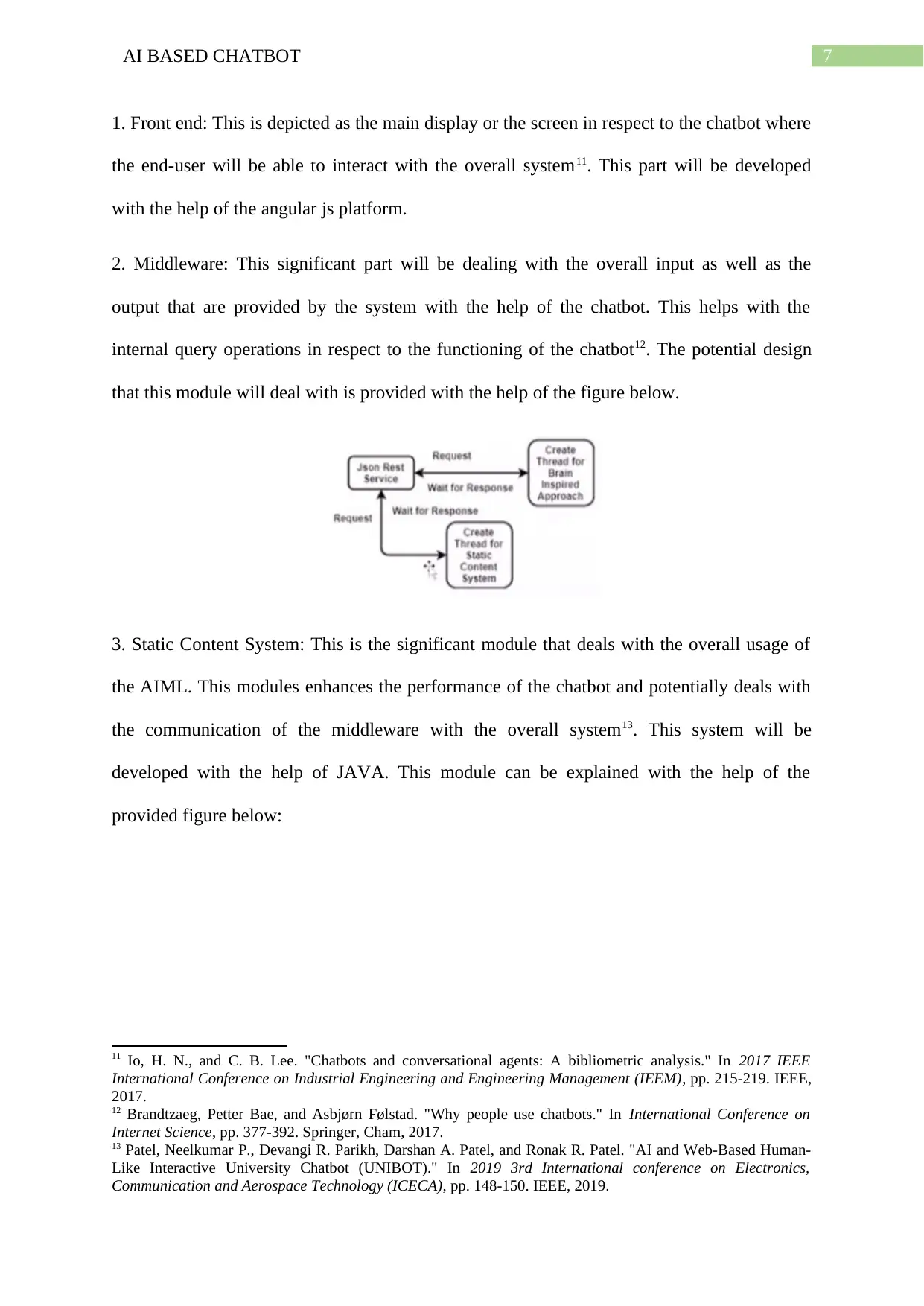
7AI BASED CHATBOT
1. Front end: This is depicted as the main display or the screen in respect to the chatbot where
the end-user will be able to interact with the overall system11. This part will be developed
with the help of the angular js platform.
2. Middleware: This significant part will be dealing with the overall input as well as the
output that are provided by the system with the help of the chatbot. This helps with the
internal query operations in respect to the functioning of the chatbot12. The potential design
that this module will deal with is provided with the help of the figure below.
3. Static Content System: This is the significant module that deals with the overall usage of
the AIML. This modules enhances the performance of the chatbot and potentially deals with
the communication of the middleware with the overall system13. This system will be
developed with the help of JAVA. This module can be explained with the help of the
provided figure below:
11 Io, H. N., and C. B. Lee. "Chatbots and conversational agents: A bibliometric analysis." In 2017 IEEE
International Conference on Industrial Engineering and Engineering Management (IEEM), pp. 215-219. IEEE,
2017.
12 Brandtzaeg, Petter Bae, and Asbjørn Følstad. "Why people use chatbots." In International Conference on
Internet Science, pp. 377-392. Springer, Cham, 2017.
13 Patel, Neelkumar P., Devangi R. Parikh, Darshan A. Patel, and Ronak R. Patel. "AI and Web-Based Human-
Like Interactive University Chatbot (UNIBOT)." In 2019 3rd International conference on Electronics,
Communication and Aerospace Technology (ICECA), pp. 148-150. IEEE, 2019.
1. Front end: This is depicted as the main display or the screen in respect to the chatbot where
the end-user will be able to interact with the overall system11. This part will be developed
with the help of the angular js platform.
2. Middleware: This significant part will be dealing with the overall input as well as the
output that are provided by the system with the help of the chatbot. This helps with the
internal query operations in respect to the functioning of the chatbot12. The potential design
that this module will deal with is provided with the help of the figure below.
3. Static Content System: This is the significant module that deals with the overall usage of
the AIML. This modules enhances the performance of the chatbot and potentially deals with
the communication of the middleware with the overall system13. This system will be
developed with the help of JAVA. This module can be explained with the help of the
provided figure below:
11 Io, H. N., and C. B. Lee. "Chatbots and conversational agents: A bibliometric analysis." In 2017 IEEE
International Conference on Industrial Engineering and Engineering Management (IEEM), pp. 215-219. IEEE,
2017.
12 Brandtzaeg, Petter Bae, and Asbjørn Følstad. "Why people use chatbots." In International Conference on
Internet Science, pp. 377-392. Springer, Cham, 2017.
13 Patel, Neelkumar P., Devangi R. Parikh, Darshan A. Patel, and Ronak R. Patel. "AI and Web-Based Human-
Like Interactive University Chatbot (UNIBOT)." In 2019 3rd International conference on Electronics,
Communication and Aerospace Technology (ICECA), pp. 148-150. IEEE, 2019.
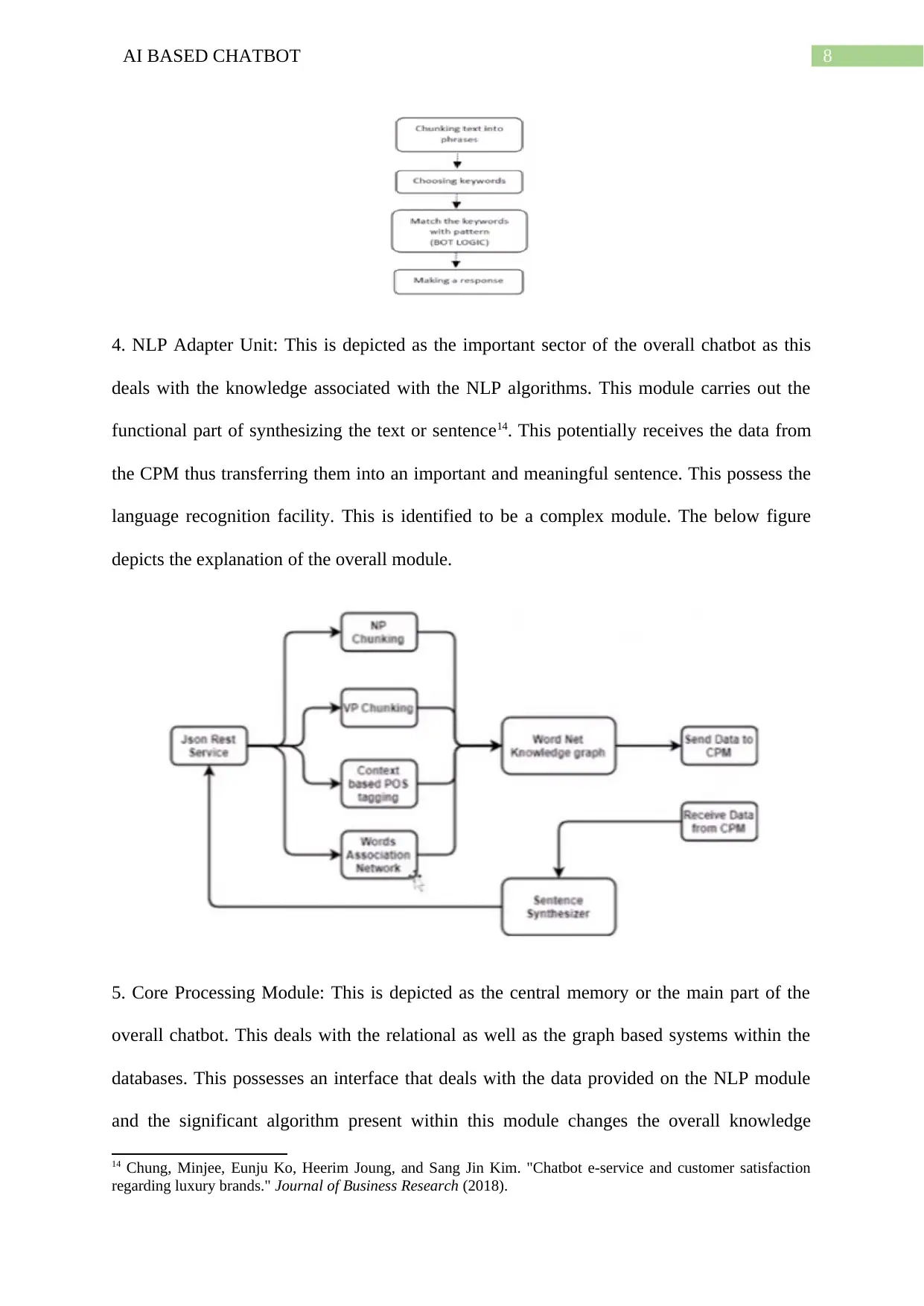
8AI BASED CHATBOT
4. NLP Adapter Unit: This is depicted as the important sector of the overall chatbot as this
deals with the knowledge associated with the NLP algorithms. This module carries out the
functional part of synthesizing the text or sentence14. This potentially receives the data from
the CPM thus transferring them into an important and meaningful sentence. This possess the
language recognition facility. This is identified to be a complex module. The below figure
depicts the explanation of the overall module.
5. Core Processing Module: This is depicted as the central memory or the main part of the
overall chatbot. This deals with the relational as well as the graph based systems within the
databases. This possesses an interface that deals with the data provided on the NLP module
and the significant algorithm present within this module changes the overall knowledge
14 Chung, Minjee, Eunju Ko, Heerim Joung, and Sang Jin Kim. "Chatbot e-service and customer satisfaction
regarding luxury brands." Journal of Business Research (2018).
4. NLP Adapter Unit: This is depicted as the important sector of the overall chatbot as this
deals with the knowledge associated with the NLP algorithms. This module carries out the
functional part of synthesizing the text or sentence14. This potentially receives the data from
the CPM thus transferring them into an important and meaningful sentence. This possess the
language recognition facility. This is identified to be a complex module. The below figure
depicts the explanation of the overall module.
5. Core Processing Module: This is depicted as the central memory or the main part of the
overall chatbot. This deals with the relational as well as the graph based systems within the
databases. This possesses an interface that deals with the data provided on the NLP module
and the significant algorithm present within this module changes the overall knowledge
14 Chung, Minjee, Eunju Ko, Heerim Joung, and Sang Jin Kim. "Chatbot e-service and customer satisfaction
regarding luxury brands." Journal of Business Research (2018).
⊘ This is a preview!⊘
Do you want full access?
Subscribe today to unlock all pages.

Trusted by 1+ million students worldwide
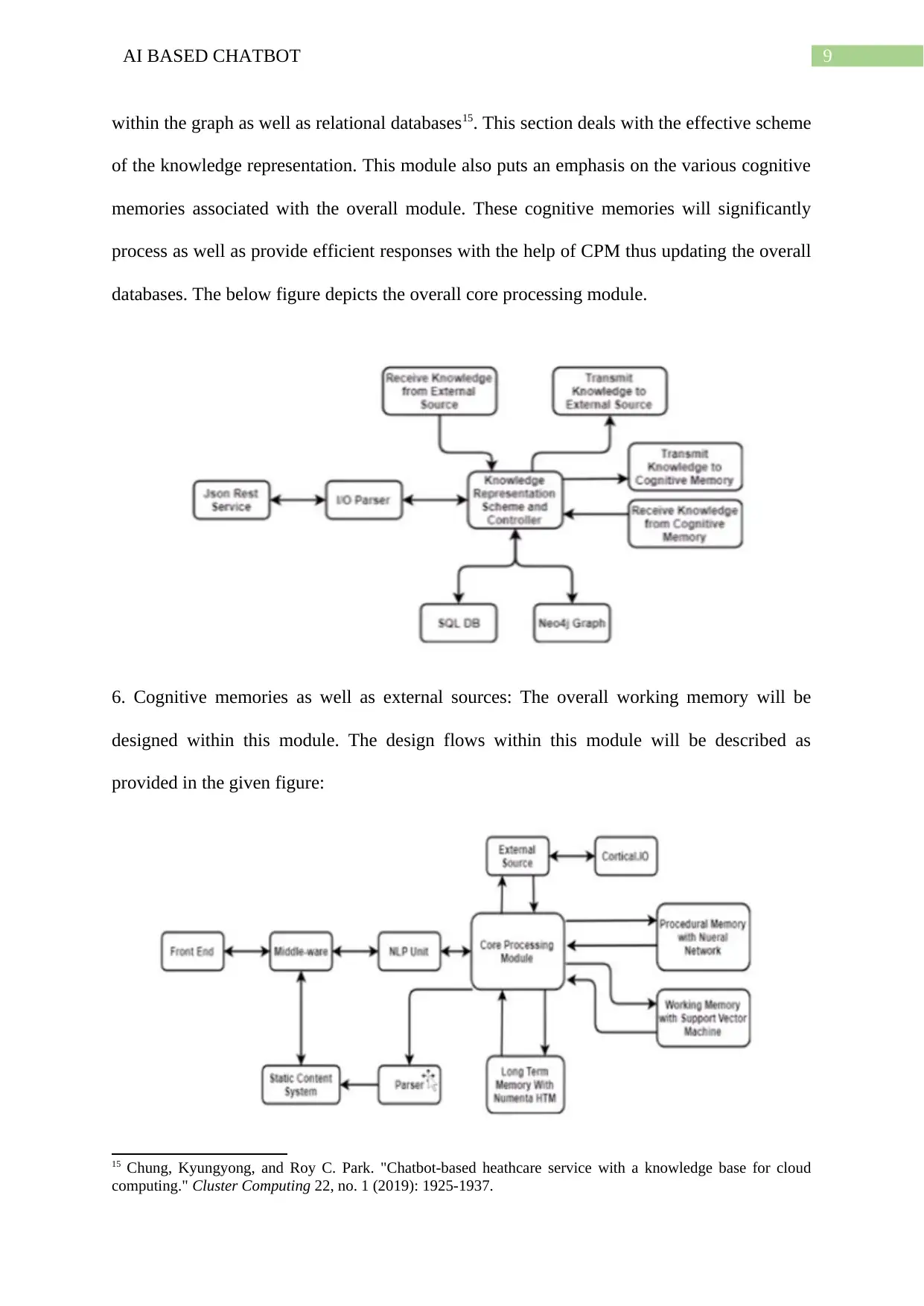
9AI BASED CHATBOT
within the graph as well as relational databases15. This section deals with the effective scheme
of the knowledge representation. This module also puts an emphasis on the various cognitive
memories associated with the overall module. These cognitive memories will significantly
process as well as provide efficient responses with the help of CPM thus updating the overall
databases. The below figure depicts the overall core processing module.
6. Cognitive memories as well as external sources: The overall working memory will be
designed within this module. The design flows within this module will be described as
provided in the given figure:
15 Chung, Kyungyong, and Roy C. Park. "Chatbot-based heathcare service with a knowledge base for cloud
computing." Cluster Computing 22, no. 1 (2019): 1925-1937.
within the graph as well as relational databases15. This section deals with the effective scheme
of the knowledge representation. This module also puts an emphasis on the various cognitive
memories associated with the overall module. These cognitive memories will significantly
process as well as provide efficient responses with the help of CPM thus updating the overall
databases. The below figure depicts the overall core processing module.
6. Cognitive memories as well as external sources: The overall working memory will be
designed within this module. The design flows within this module will be described as
provided in the given figure:
15 Chung, Kyungyong, and Roy C. Park. "Chatbot-based heathcare service with a knowledge base for cloud
computing." Cluster Computing 22, no. 1 (2019): 1925-1937.
Paraphrase This Document
Need a fresh take? Get an instant paraphrase of this document with our AI Paraphraser
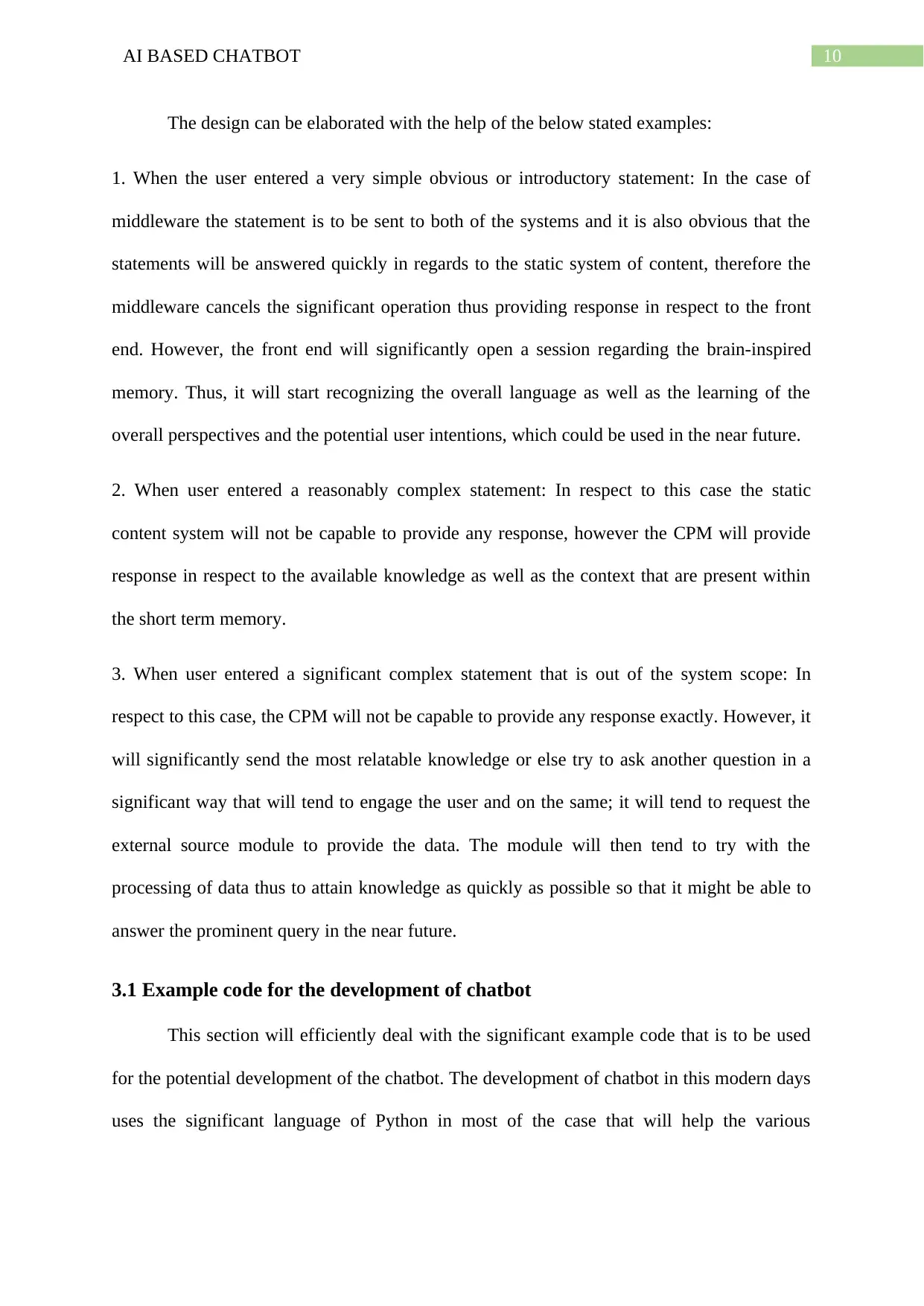
10AI BASED CHATBOT
The design can be elaborated with the help of the below stated examples:
1. When the user entered a very simple obvious or introductory statement: In the case of
middleware the statement is to be sent to both of the systems and it is also obvious that the
statements will be answered quickly in regards to the static system of content, therefore the
middleware cancels the significant operation thus providing response in respect to the front
end. However, the front end will significantly open a session regarding the brain-inspired
memory. Thus, it will start recognizing the overall language as well as the learning of the
overall perspectives and the potential user intentions, which could be used in the near future.
2. When user entered a reasonably complex statement: In respect to this case the static
content system will not be capable to provide any response, however the CPM will provide
response in respect to the available knowledge as well as the context that are present within
the short term memory.
3. When user entered a significant complex statement that is out of the system scope: In
respect to this case, the CPM will not be capable to provide any response exactly. However, it
will significantly send the most relatable knowledge or else try to ask another question in a
significant way that will tend to engage the user and on the same; it will tend to request the
external source module to provide the data. The module will then tend to try with the
processing of data thus to attain knowledge as quickly as possible so that it might be able to
answer the prominent query in the near future.
3.1 Example code for the development of chatbot
This section will efficiently deal with the significant example code that is to be used
for the potential development of the chatbot. The development of chatbot in this modern days
uses the significant language of Python in most of the case that will help the various
The design can be elaborated with the help of the below stated examples:
1. When the user entered a very simple obvious or introductory statement: In the case of
middleware the statement is to be sent to both of the systems and it is also obvious that the
statements will be answered quickly in regards to the static system of content, therefore the
middleware cancels the significant operation thus providing response in respect to the front
end. However, the front end will significantly open a session regarding the brain-inspired
memory. Thus, it will start recognizing the overall language as well as the learning of the
overall perspectives and the potential user intentions, which could be used in the near future.
2. When user entered a reasonably complex statement: In respect to this case the static
content system will not be capable to provide any response, however the CPM will provide
response in respect to the available knowledge as well as the context that are present within
the short term memory.
3. When user entered a significant complex statement that is out of the system scope: In
respect to this case, the CPM will not be capable to provide any response exactly. However, it
will significantly send the most relatable knowledge or else try to ask another question in a
significant way that will tend to engage the user and on the same; it will tend to request the
external source module to provide the data. The module will then tend to try with the
processing of data thus to attain knowledge as quickly as possible so that it might be able to
answer the prominent query in the near future.
3.1 Example code for the development of chatbot
This section will efficiently deal with the significant example code that is to be used
for the potential development of the chatbot. The development of chatbot in this modern days
uses the significant language of Python in most of the case that will help the various
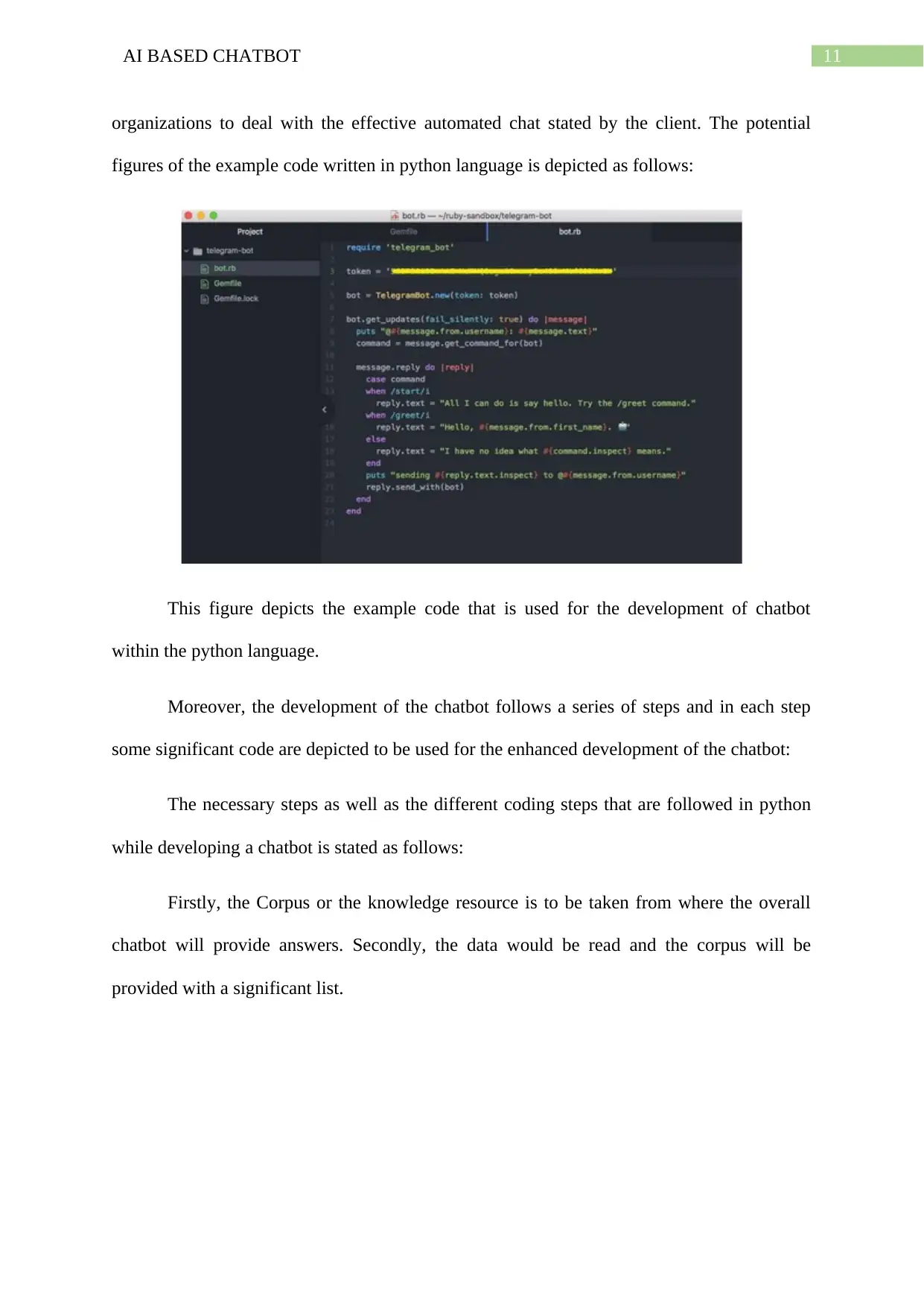
11AI BASED CHATBOT
organizations to deal with the effective automated chat stated by the client. The potential
figures of the example code written in python language is depicted as follows:
This figure depicts the example code that is used for the development of chatbot
within the python language.
Moreover, the development of the chatbot follows a series of steps and in each step
some significant code are depicted to be used for the enhanced development of the chatbot:
The necessary steps as well as the different coding steps that are followed in python
while developing a chatbot is stated as follows:
Firstly, the Corpus or the knowledge resource is to be taken from where the overall
chatbot will provide answers. Secondly, the data would be read and the corpus will be
provided with a significant list.
organizations to deal with the effective automated chat stated by the client. The potential
figures of the example code written in python language is depicted as follows:
This figure depicts the example code that is used for the development of chatbot
within the python language.
Moreover, the development of the chatbot follows a series of steps and in each step
some significant code are depicted to be used for the enhanced development of the chatbot:
The necessary steps as well as the different coding steps that are followed in python
while developing a chatbot is stated as follows:
Firstly, the Corpus or the knowledge resource is to be taken from where the overall
chatbot will provide answers. Secondly, the data would be read and the corpus will be
provided with a significant list.
⊘ This is a preview!⊘
Do you want full access?
Subscribe today to unlock all pages.

Trusted by 1+ million students worldwide
1 out of 20
Related Documents
Your All-in-One AI-Powered Toolkit for Academic Success.
+13062052269
info@desklib.com
Available 24*7 on WhatsApp / Email
![[object Object]](/_next/static/media/star-bottom.7253800d.svg)
Unlock your academic potential
Copyright © 2020–2025 A2Z Services. All Rights Reserved. Developed and managed by ZUCOL.





